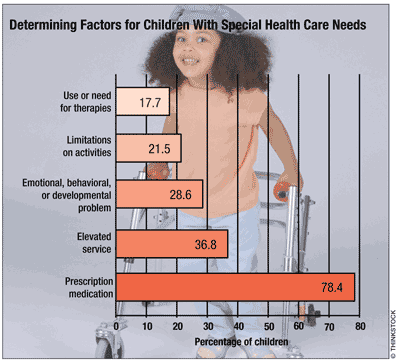US Pharm. 2010;35(3):62.
In 2008, there were 73.9 million children aged 0 to 17 years. Overall, 22% of all U.S. households with children had at least 1 child with special health care needs (SHCN). Children with SHCN suffer from chronic physical, developmental, behavioral, or emotional difficulties. The proportion of children with SHCN increased from 13% in 2001 to 14% in 2005–2006. According to the Maternal and Child Health Bureau and the National Center for Health Statistics, 67% of parents reported that their children had up to 2 health conditions that rendered them needful of special health care services.

Prevalence: The number of children with SHCN increased with age, from 9% of children aged 0 to 5 years to 17% of those aged 12 to 17 years. Children with SHCN constituted 16% of boys and 12% of girls. Prevalence of SHCN was highest among children of 2 or more races (18%), followed by non-Hispanic white (15%), non-Hispanic black (15%), American Indian or Alaskan Native (15%), and Native Hawaiian or other Pacific Islander (12%) children. Prevalence of SHCN was lowest among Hispanic and Asian children (8% and 6%, respectively). Most children with SHCN had private health insurance (59%); 28% had public health insurance only, 7% were covered by a combination of public and private health insurance, and 3% were uninsured.
Activity Limitation: There was no effect on daily activities in 38% of children with SHCN, while 24% were usually or always affected; more boys than girls were affected. In 2007, 8% of children had activity limitation due to chronic conditions, 7% were receiving special education, and 2% were limited in their ability to walk or care for themselves.
Emotional/Behavioral Difficulties: Between 2001 and 2007, the percentage of children with serious emotional or behavioral difficulties remained stable at 5%, rising in 2007 to slightly more than 5%; more boys than girls were affected. Seven percent of children living below poverty level or in families with incomes 100% to 199% of poverty level had serious emotional or behavioral difficulties, versus 4% of children with family incomes 200% or more of poverty level. Eighty-six percent of parents of children with serious difficulties contacted a health care provider or school staff about their child’s difficulties; 46% of children with SHCN were prescribed medication for their emotional/behavioral difficulties, and 51% received treatment or help other than medication.
Medications: The most commonly reported health conditions among children with SHCN were allergies (53%); asthma (39%); attention-deficit/hyperactivity disorder (30%); depression, anxiety, or other emotional problems (21%); and migraine or frequent headaches (15%). About 78% of children with SHCN were taking prescription medications, and 39% needed elevated services.
To comment on this article, contact rdavidson@uspharmacist.com.





